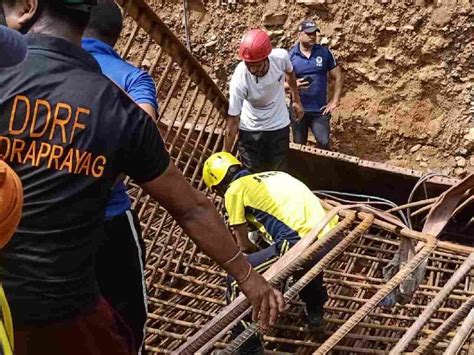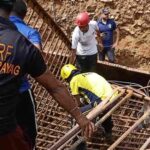
Two individuals are confirmed dead and dozens injured following the collapse of a pedestrian bridge at a popular tourist destination in Indonesia on Sunday. The Yellow Bridge, connecting Nusa Lembongan and Nusa Ceningan islands in Bali, gave way, sending tourists and locals plummeting into the sea below.
NUSA LEMBONGAN, Bali – A suspension bridge connecting two popular tourist islands in Bali, Indonesia, collapsed on Sunday, resulting in the deaths of two people and leaving dozens injured, according to local authorities. The Yellow Bridge, also known as the Cinta Bridge, which linked Nusa Lembongan and Nusa Ceningan, crumbled at approximately 6:30 p.m. local time (0630 GMT) when it was heavily congested with people celebrating a religious festival.
“The bridge collapsed because it was overcapacity. Many people were passing through because there was a religious ceremony,” stated Nusa Penida police chief, Adjunct Commissioner Ida Bagus Putra Sumerta, as quoted by The Associated Press. The collapse triggered a frantic rescue operation involving local residents, police, and emergency services.
Initial reports indicate that the victims were primarily locals participating in the Hindu ceremony of Melasti, a purification ritual held a few days before Nyepi, the Balinese Day of Silence, which falls on March 11 this year. The bridge is a vital artery for both residents and tourists, facilitating travel between the two islands known for their pristine beaches, diving spots, and laid-back atmosphere.
The extent of the injuries varies, with some suffering broken bones and head wounds. Medical teams were dispatched to the scene to provide immediate assistance, and the injured were transported to nearby clinics and hospitals on both Nusa Lembongan and the mainland. The search and rescue operation continued late into the night to ensure no one remained trapped in the wreckage.
The National Disaster Mitigation Agency (BNPB) dispatched a team to the site to assess the damage and coordinate relief efforts. Sutopo Purwo Nugroho, a spokesman for the BNPB, confirmed the casualties and emphasized the need for a thorough investigation to determine the exact cause of the collapse and prevent similar incidents in the future. He also expressed his condolences to the families of the victims and pledged government support for the injured and bereaved.
The Yellow Bridge was a well-known landmark and a significant piece of infrastructure for the two islands. Its collapse is expected to have a considerable impact on the local economy, particularly tourism, which is a major source of income for the residents of Nusa Lembongan and Nusa Ceningan. The bridge’s destruction now forces travelers to take a significantly longer and more arduous route by boat to travel between the islands.
Local authorities have initiated an investigation to determine the cause of the collapse. Preliminary investigations suggest that the bridge’s structural integrity may have been compromised due to years of wear and tear and inadequate maintenance. Overloading on the day of the incident is also believed to have been a contributing factor. Witnesses reported that the bridge was swaying noticeably before it collapsed, indicating that it was under significant strain.
The incident has raised concerns about the safety of infrastructure in popular tourist destinations across Indonesia. Critics argue that the rapid growth of tourism has put pressure on existing infrastructure, leading to overcrowding and inadequate maintenance. Calls are growing for stricter regulations and more investment in infrastructure to ensure the safety of both tourists and local residents.
The Indonesian government has pledged to conduct a comprehensive review of infrastructure safety standards and to allocate resources for the repair and upgrading of critical infrastructure in tourist areas. The Ministry of Tourism has also announced plans to launch a public awareness campaign to educate tourists about safety precautions and responsible travel practices.
The collapse of the Yellow Bridge is a tragic reminder of the importance of infrastructure maintenance and safety in tourist destinations. It highlights the need for governments and tourism operators to prioritize safety and to invest in infrastructure that can withstand the pressures of tourism. The incident serves as a cautionary tale for other popular tourist destinations around the world, emphasizing the need for proactive measures to prevent similar tragedies from occurring.
As investigations continue, the local community is grappling with the aftermath of the disaster. Religious leaders have called for prayers and solidarity, while residents have come together to support the families of the victims and to help with the cleanup efforts. The spirit of resilience and community is evident as Nusa Lembongan and Nusa Ceningan begin the long process of recovery.
The disaster also casts a shadow over the upcoming Nyepi celebrations. While the holiday will still be observed, the mood will be somber as the community mourns the loss of life and reflects on the importance of safety and preparedness. The government has assured the public that all necessary measures are being taken to ensure the safety of residents and tourists during the holiday period.
In the wake of the tragedy, the focus is now on providing support to the victims and their families, investigating the cause of the collapse, and rebuilding the bridge to restore connectivity between the two islands. The incident serves as a wake-up call for Indonesia and other tourist destinations to prioritize infrastructure safety and to ensure that tourism development is sustainable and responsible. The long-term impact on tourism in Nusa Lembongan and Nusa Ceningan remains to be seen, but the incident is likely to have a significant impact on the local economy and the lives of the residents.
Further details emerging from the scene indicate that the bridge had undergone repairs in the past, but these repairs may not have been sufficient to address the underlying structural issues. Some locals claim that the bridge was known to be unstable, and there were concerns about its capacity to handle large crowds. These concerns were apparently heightened in the lead-up to the religious ceremony, which drew large numbers of people to the bridge.
The investigation will focus on determining whether the repairs were adequate, whether the bridge’s capacity was properly assessed, and whether there were any warning signs that were ignored. The findings of the investigation will be crucial in determining accountability and in preventing similar incidents from occurring in the future.
The Indonesian government has expressed its commitment to providing assistance to the victims and their families and to ensuring that the bridge is rebuilt as quickly as possible. However, the rebuilding process is likely to be complex and time-consuming, given the need to ensure that the new bridge is structurally sound and capable of withstanding the pressures of tourism and daily use.
In the meantime, the local community will have to rely on alternative means of transportation to travel between the two islands. This is likely to cause significant disruption and inconvenience, particularly for those who rely on the bridge for their livelihoods. The government has promised to provide temporary transportation assistance to help mitigate the impact of the bridge’s collapse.
The tragedy has also sparked a debate about the role of tourism in Indonesia and the need to balance economic development with environmental and social responsibility. Critics argue that the rapid growth of tourism has led to unsustainable practices, including overdevelopment, environmental degradation, and cultural commodification. They call for a more sustainable and responsible approach to tourism that prioritizes the well-being of local communities and the protection of the environment.
The collapse of the Yellow Bridge is a stark reminder of the challenges and risks associated with tourism development. It highlights the need for a holistic and integrated approach to tourism planning that takes into account the economic, social, and environmental impacts of tourism. It also underscores the importance of investing in infrastructure and ensuring that it is properly maintained to protect the safety of both tourists and local residents.
The incident is likely to have a lasting impact on Nusa Lembongan and Nusa Ceningan, both economically and socially. The loss of life is a tragedy that will be mourned for years to come. The economic impact of the bridge’s collapse is likely to be significant, particularly in the short term. The long-term impact will depend on how quickly the bridge is rebuilt and how effectively the government and the tourism industry address the underlying issues that contributed to the tragedy.
The international community has expressed its condolences to the Indonesian government and the people of Nusa Lembongan and Nusa Ceningan. Many countries have offered assistance to help with the rescue and recovery efforts. The incident has also prompted a review of safety standards for bridges and other infrastructure in tourist destinations around the world.
The collapse of the Yellow Bridge is a tragedy that could have been prevented. It is a wake-up call for Indonesia and other tourist destinations to prioritize infrastructure safety and to ensure that tourism development is sustainable and responsible. The lessons learned from this tragedy must be applied to prevent similar incidents from occurring in the future. The memories of those who were lost must serve as a constant reminder of the importance of safety and preparedness. The rebuilding of the bridge must be a symbol of hope and resilience, a testament to the strength of the community and its determination to overcome adversity.
The investigation into the collapse will continue to unfold in the coming weeks and months. Expert engineers will analyze the wreckage to determine the exact cause of the failure. Police will interview witnesses and collect evidence to determine whether any negligence or wrongdoing contributed to the tragedy. The findings of the investigation will be made public and will be used to inform future safety regulations and infrastructure development.
The government has promised to take swift action to address the issues that led to the collapse and to ensure that similar incidents do not occur in the future. This will include a comprehensive review of infrastructure safety standards, increased investment in infrastructure maintenance and upgrades, and stricter enforcement of safety regulations. The government will also work with the tourism industry to promote sustainable and responsible tourism practices.
The people of Nusa Lembongan and Nusa Ceningan are resilient and determined to rebuild their lives and their community. They are working together to support the families of the victims, to clean up the wreckage, and to plan for the future. They are determined to ensure that the tragedy of the Yellow Bridge collapse will not define them, but rather will serve as a catalyst for positive change. They are committed to building a stronger, safer, and more sustainable future for their community.
The healing process will be long and difficult, but the spirit of community and the determination to overcome adversity will help the people of Nusa Lembongan and Nusa Ceningan to move forward. The memories of those who were lost will be honored, and their legacy will inspire future generations to work for a better future. The Yellow Bridge will be rebuilt, stronger and safer than before, and it will once again connect the two islands, symbolizing the resilience and the enduring spirit of the community. The incident serves as a reminder of the fragility of life and the importance of cherishing every moment. It also underscores the power of community and the ability of people to come together in the face of adversity. The rebuilding process will be a testament to the strength and the resilience of the human spirit.
The initial response to the disaster was hampered by the remote location of the islands and the limited availability of resources. However, local residents, police, and emergency services worked tirelessly to rescue the injured and recover the bodies of the deceased. The search and rescue operation was conducted under difficult conditions, with limited visibility and strong currents. Despite these challenges, the rescuers persevered, demonstrating their commitment to saving lives and providing assistance to those in need.
The Indonesian Red Cross and other humanitarian organizations provided medical care, food, and shelter to the victims and their families. Volunteers from across the country traveled to Nusa Lembongan and Nusa Ceningan to offer their support. The outpouring of compassion and generosity was a testament to the spirit of humanity and the willingness of people to help others in times of need.
The incident has also highlighted the importance of disaster preparedness and response. The lack of adequate emergency resources and infrastructure on the islands hampered the initial response to the disaster. This underscores the need for governments and communities to invest in disaster preparedness and to develop comprehensive emergency response plans. These plans should include procedures for search and rescue, medical care, evacuation, and communication. They should also address the specific needs of vulnerable populations, such as the elderly, the disabled, and children.
The disaster has also raised questions about the role of social media in emergency response. Social media platforms were used to disseminate information about the collapse and to coordinate rescue efforts. However, they were also used to spread misinformation and rumors, which hampered the rescue efforts and caused confusion and anxiety. This underscores the need for responsible use of social media during emergencies and for accurate and reliable information dissemination.
The Indonesian government has launched an investigation into the role of social media in the disaster response. The investigation will focus on identifying sources of misinformation and rumors and on developing strategies to combat the spread of false information during emergencies. The government will also work with social media companies to promote responsible use of their platforms during disasters.
The collapse of the Yellow Bridge is a tragedy that will be remembered for years to come. It is a reminder of the importance of infrastructure safety, disaster preparedness, and responsible tourism. It is also a testament to the resilience of the human spirit and the power of community. The lessons learned from this tragedy must be applied to prevent similar incidents from occurring in the future and to build a safer and more sustainable future for all. The long-term economic consequences of the bridge collapse are still uncertain. Tourism is the lifeblood of both Nusa Lembongan and Nusa Ceningan, and the sudden disruption to transportation could have a chilling effect on visitor numbers. Businesses dependent on tourism, such as hotels, restaurants, dive operators, and souvenir shops, may face significant losses. The rebuilding of the bridge is crucial to restoring economic stability to the region. However, the process could take months, or even years, to complete. In the meantime, the government and local businesses will need to explore alternative ways to support the tourism industry and mitigate the economic impact of the disaster.
The Balinese government is exploring options such as improving ferry services between the islands and investing in alternative transportation infrastructure. They are also considering implementing marketing campaigns to promote Nusa Lembongan and Nusa Ceningan as safe and attractive tourist destinations, despite the bridge collapse. These efforts will be essential to maintaining the islands’ appeal and preventing a long-term decline in tourism.
The environmental impact of the bridge collapse is also a concern. The debris from the collapsed bridge could damage coral reefs and other marine ecosystems. The government is working to remove the debris and mitigate any environmental damage. Environmental experts are assessing the long-term impact of the collapse on the marine environment and developing strategies to protect it.
The cultural impact of the bridge collapse should also not be overlooked. The Yellow Bridge was a landmark and a symbol of connection between the two islands. Its loss has created a sense of loss and disruption for the local community. The rebuilding of the bridge will be more than just a physical reconstruction; it will also be a symbolic act of healing and renewal. The government and the community will need to work together to ensure that the new bridge reflects the cultural heritage and the values of the people of Nusa Lembongan and Nusa Ceningan. The bridge was often featured in social media posts by tourist, which further boosted its popularity before this unfortunate event.
The tragedy has triggered a wave of empathy and support from across Indonesia and around the world. Donations and aid have poured in to help the victims and their families. Volunteers have traveled to the islands to assist with the cleanup and recovery efforts. The outpouring of support is a testament to the power of human compassion and the willingness of people to help those in need.
The Indonesian government has established a task force to oversee the reconstruction of the bridge and to coordinate the recovery efforts. The task force includes representatives from the central government, the provincial government, the local government, and the community. The task force is responsible for developing a comprehensive reconstruction plan, securing funding for the project, and ensuring that the reconstruction is carried out in a timely and efficient manner.
The reconstruction plan will take into account the lessons learned from the bridge collapse. The new bridge will be designed to be stronger, safer, and more resilient to natural disasters. It will also be designed to be more environmentally friendly and to minimize its impact on the marine environment. The reconstruction plan will also address the need for improved disaster preparedness and response on the islands.
The Indonesian government is committed to rebuilding the Yellow Bridge and to restoring economic stability to Nusa Lembongan and Nusa Ceningan. The government is also committed to ensuring that tourism in the region is sustainable and responsible. The tragedy of the bridge collapse has served as a wake-up call, and the government is determined to learn from the experience and to build a better future for the people of Nusa Lembongan and Nusa Ceningan. The incident also prompted a response from the Tourism Minister, Sandiaga Uno, expressing his condolences.
The incident has raised broader questions about infrastructure safety in Indonesia, particularly in areas heavily reliant on tourism. A comprehensive review of existing infrastructure is expected, with a focus on identifying potential weaknesses and implementing preventative measures. This review is likely to encompass bridges, roads, and other critical infrastructure elements used by both locals and tourists. The goal is to ensure such facilities meet stringent safety standards and undergo regular maintenance to prevent future disasters. Furthermore, the tragedy has led to increased scrutiny of the oversight and regulatory mechanisms governing construction and maintenance of public infrastructure in Indonesia. Calls for greater transparency and accountability are growing louder, with stakeholders urging the government to strengthen enforcement of safety regulations and address any systemic issues that may have contributed to the bridge collapse.
The aftermath of the bridge collapse underscores the crucial role of effective emergency response systems. The challenges encountered in the initial hours following the incident highlighted the need for improved coordination among rescue teams, better access to emergency medical services, and enhanced communication channels. Investing in training and resources for first responders, establishing clear protocols for disaster management, and ensuring adequate infrastructure for emergency response are essential steps to mitigate the impact of future crises.
In the long run, the rebuilding of the Yellow Bridge will symbolize the resilience of the Nusa Lembongan and Nusa Ceningan communities and their determination to overcome adversity. The new bridge will not only restore vital transportation links but also serve as a powerful reminder of the importance of infrastructure safety, disaster preparedness, and responsible tourism. As the reconstruction efforts move forward, it is essential for all stakeholders to work collaboratively to ensure that the new bridge is built to the highest standards and that the lessons learned from this tragedy are fully incorporated into future infrastructure projects in Indonesia and beyond. The incident has spurred discussions on sustainable tourism practices, emphasizing the need for a balance between economic development and environmental protection. Stricter regulations and monitoring of tourist activities are being considered to minimize the impact on local ecosystems and ensure the long-term viability of tourism in Nusa Lembongan and Nusa Ceningan.
The Balinese people, known for their strong sense of community and resilience, are rallying to support the affected families and rebuild their lives. Religious ceremonies and cultural traditions are playing an important role in the healing process, providing solace and strength to those who have suffered losses. The spirit of “gotong royong,” the Balinese concept of mutual assistance and cooperation, is evident in the community’s collective efforts to overcome this tragedy and move forward together. The local government has also committed to providing counseling and psychological support to those affected by the bridge collapse, recognizing the importance of addressing the emotional and mental health needs of the community.
The event highlights the interconnectedness of tourism, infrastructure, and community well-being. A holistic approach to tourism development is needed, one that prioritizes the safety and welfare of both visitors and local residents. This approach should include investments in infrastructure, strengthened regulatory oversight, promotion of sustainable tourism practices, and engagement of local communities in decision-making processes. By addressing these interconnected issues, Indonesia can create a more resilient and sustainable tourism sector that benefits all stakeholders.
The Yellow Bridge collapse serves as a cautionary tale for other tourist destinations around the world. It underscores the importance of proactive infrastructure maintenance, rigorous safety standards, and comprehensive disaster preparedness. By learning from this tragedy, other communities can take steps to prevent similar incidents and ensure the safety and well-being of their residents and visitors. The world is watching as Nusa Lembongan and Nusa Ceningan recover from this tragedy. The rebuilding of the Yellow Bridge will be a symbol of hope, resilience, and the power of community. It will also serve as a reminder of the importance of prioritizing safety, sustainability, and responsible tourism in all aspects of development.
Frequently Asked Questions (FAQ)
1. What caused the Yellow Bridge in Bali to collapse?
Preliminary investigations suggest that the bridge collapsed due to a combination of factors. These include potential structural weaknesses resulting from years of wear and tear and inadequate maintenance, coupled with overloading on the day of the incident due to a religious ceremony. “The bridge collapsed because it was overcapacity. Many people were passing through because there was a religious ceremony,” stated Nusa Penida police chief, Adjunct Commissioner Ida Bagus Putra Sumerta, as quoted by The Associated Press. The investigation is still ongoing to determine the definitive cause.
2. How many casualties resulted from the bridge collapse?
As of the latest reports, the collapse resulted in two confirmed deaths and dozens of injuries. The injured have been transported to nearby clinics and hospitals for medical treatment. Search and rescue operations continued to ensure no one remained trapped.
3. What is the immediate impact on tourism in Nusa Lembongan and Nusa Ceningan?
The bridge’s collapse is expected to have a significant negative impact on tourism, a major source of income for the residents. Travelers now face a longer and more difficult journey by boat between the islands. The extent of the long-term impact depends on how quickly the bridge is rebuilt and how effectively the government and tourism industry address the issues arising from the collapse.
4. What is the Indonesian government doing in response to the collapse?
The Indonesian government has dispatched a team to assess the damage and coordinate relief efforts. It has also pledged to conduct a comprehensive review of infrastructure safety standards and to allocate resources for the repair and upgrading of critical infrastructure in tourist areas. The Ministry of Tourism has announced plans to launch a public awareness campaign to educate tourists about safety precautions and responsible travel practices. A task force has also been established to oversee the reconstruction.
5. What measures are being considered to prevent similar incidents in the future?
Several measures are being considered to prevent similar tragedies, including:
- A comprehensive review of infrastructure safety standards across Indonesia, particularly in tourist destinations.
- Increased investment in infrastructure maintenance and upgrades.
- Stricter enforcement of safety regulations.
- Improved disaster preparedness and response plans.
- Promotion of sustainable and responsible tourism practices.
- Reviewing oversight and regulatory mechanisms governing construction and maintenance of public infrastructure.









